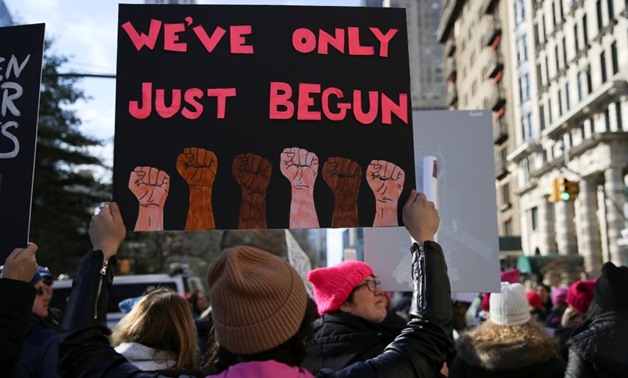
Demonstrators take part in the Women's March in Manhattan in New York City, New York, U.S., January 20, 2018. REUTERS/Caitlin Ochs
CAIRO – 21 January 2018: Once again the “Women’s March Global”, and on the anniversary of 2017 Women’s March, coordinated protests took place in many cities in the U.S. with parallel rallies in Canada, Japan, Italy and other countries around the world under what was called the “Weekend of Women”. Starting on Saturday; the 2018 Women’s Global March and events were organized under the theme “Look Back, March Forward”, attracting thousands of people to a growing international movement.
In the U.S., one year after Trump’s inauguration, the march was more political with protests against Trump and his administration’s policies on health care, reproductive rights, immigration, and other issues. The marches were organized under the theme “Power to the Polls”, encouraging women to run for office and calling for greater women participation in the coming midterm elections. Moreover, the march took place one day after the shutdown of the federal government in the U.S. as the congress failed to reach a compromise on a spending measure. This government shutdown is the first since 2013.
According to a poll conducted by NBC News and The Washington Post, Trump capped the lowest overall approval ratings of any president in modern history of the U.S. with 39 percent.
Donald Trump commented on the Women’s March with a tweet through his official Twitter account, saying that the weather is beautiful to celebrate the lowest female unemployment in 18 years.
The global marches also supported the #MeToo movement and the Hollywood’s “Time’s Up” initiative as both represent a power up force for victims and survivors of sexual misconduct to speak up, say no to social stigma and abuse of power and demand stronger social and political change.
More events are planned to take place on Sunday, with celebrities to be a big feature including Eva Longoria, Olivia Munn, Scarlett Johansson, Alyssa Milano, Viola Davis and Cher.
In 2017, hundreds of thousands of women in the U.S. and around the world took to the streets to protest Trump’s inauguration. The 2017 Women’s March was described as the largest day of protests in the U.S. history with the participation of about 4.6 million marchers, according to the Independent. The 2017 women’s marches were also the most talked about event on Facebook globally, according to UN Women.
In their mission statement, the Women’s March Global describe themselves as: “We are a grassroots coalition and we have together built a network that continues to unite and fight for the freedom and liberation of all people worldwide. This resistance needs all of us, every day, fighting for the collective liberation of all people. Because none of us are free until ALL of us are free.”
The year 2017 witnessed noteworthy moments for women’s rights and gender equality, including Iceland’s equal pay legislation, several laws’ changes in many countries that aim to hold violence perpetrators accountable for their crimes, Saudi women being able to drive cars for the first time in the Kingdom’s history, and the #MeToo. Women around the world are looking forward to more achievements for women and all human beings and aiming to introduce a new feminist discourse of inclusion and equality that represents all society segments.
To follow the live update of the 2018 Women’s March; visit:


Comments
Leave a Comment